Don't even think about teaching another lesson until you read this!
Being a good communicator is one of the most important skills you can have as an educator, especially now. How you communicate in and outside your classroom is a big deal.
In fact, without effective communication skills, you unknowingly and unintentionally create distance between you and your students, their parents, or your co-workers. Such distance will make it even more difficult, if not impossible, for your students and others to understand whatever it is you want to teach them.
Furthermore, without effective communication skills, you risk creating misunderstanding among your students, which can lead to apathy, resentment, absenteeism, higher dropout rates, anger, conflict, chaos, and violence in your classroom.
However, with effective communication skills you will be able to:
- Capture the full attention of your students (co-workers, and/or parents)
- Make people around you feel heard and empowered to succeed in school, work, and/or life.
That’s why you got into education in the first place, isn’t it?
Furthermore, being a good communicator can help you:
- Improve your social skills so you can be more highly regarded by others.
- Improve your listening skills so you can deepen your understanding people you care about.
- Improve your decision-making skills so you can get better results in your classroom.
- Improve your problem-solving abilities so you can have more peace of mind.
- Build up your self-confidence and self-esteem, which will help make everything in your life better.
- Raise the morale of your co-workers so they feel heard and valued.
- Improve your overall work environment so that your school and community can flourish.
Also, with the rapid changes taking place in schools, in terms of growing ethnic, socioeconomic, religious, and political diversity, it is so important that you be very intentional about becoming an effective communicator.
Your success as an educator depends on it.
"The single biggest problem in communication is the illusion that it has taken place." -George Bernard Shaw.
What is Effective Communication?
After looking at 126 definitions for communication (Dance and Larson, 1976), I came up with this basic definition for classroom teachers in particular, but it applies to educators in general:
Effective Communication is a process in which teachers create shared meaning with their students.
At its most basic level, whenever you try to teach anything to your students, you are participating in a process in which you and your students must work to arrive at a common understanding. By “common understanding,” I mean that your students “get” exactly what you intend for them to understand, and you “get” exactly what they intend for you to understand. When common understanding is achieved, you and your students have created “shared meaning.”
To create “shared meaning,” you as a teacher must understand the communication process. That process involves four things. The first one involves symbols.
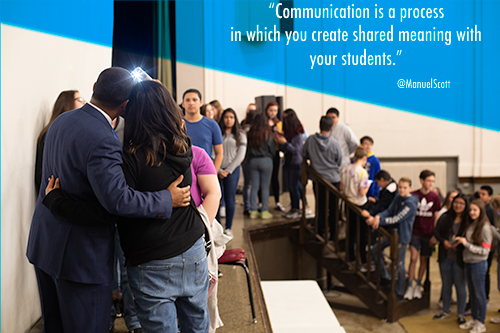
What Do Symbols Have to Do with Teaching?
Whenever you express yourself to your students, through messages or lessons, you use symbols (also, a message is nothing more than a group of symbols arranged and transmitted to your students).
Each of the following things are symbols- things to which people arbitrarily assign meanings (by that, I mean there is no necessary relationship between symbols and their meanings, but more on that in a minute):
- Words
- Objects
- Sounds
- Eye contact
- Facial expressions
- Body language
- Hand gestures
- Body movement
- Actions
- Non-actions
Since all of the above are symbols, then these things are symbols too:
- The Pledge of Allegiance.
- Wearing your favorite team’s jersey.
- Walking into a room and not speaking to anyone.
- Wearing jewelry or clothing.
- The posters hanging on your wall.
- The movies you show your students.
- The illustrations you use in your lesson plans.
- Athletes kneeling during the National Anthem.
- The phrases, “Blue Lives Matter” and “Black Lives Matter.”
- President Donald Trump’s Campaign Motto, “Make America Great Again.”
The fact is, everything you say and do as a teacher is symbolic. That is, the symbols you use are communicating something at all times. Every time you say or do- or don't do- anything, you are communicating verbal messages as well as non-verbal messages to others. Those symbols, on the surface, are merely puzzles that your students and others must interpret.
"The most important thing in communication is hearing what isn't said." -Peter Drucker
How do your students interpret your use of symbols? Do they "get" you?
How do your students use symbols? Do you "get" them?
I hope so.
With that in mind, let’s add to our working definition of communication. What is effective communication?
Effective Communication is a symbolic process in which which you as a teacher create shared meaning with your students.
Teaching involves symbols.
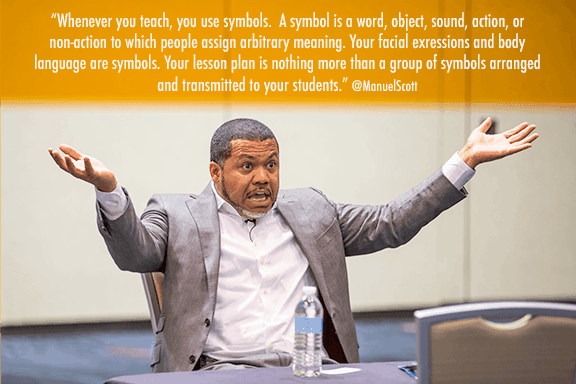
How Do Your Students Interpret Your Symbols?
What you need to know about symbols is this: there is no necessary (or obvious) relationship between a symbol and its meaning. That is, the meanings you attach to the symbols you use in your classroom are probably different from the meaning your students initially attach to those symbols. Why? Symbolic Interactionism, a theory in sociology, helps us understand how people interpret symbols. It is based on three fundamental beliefs:
- Human beings act toward things on the basis of the (subjective) meanings those things have for them (personally).
- The (subjective) meaning of such things derives from the social interaction a person has with his/her "fellows" (family, friends, and earliest teachers).
- These meanings are handled in, and modified through an interpretive process. (Blumer, 1986)
In other words, your students' behaviors flows from their beliefs; their beliefs are based upon how they interpret symbols; and, how they interpret symbols is based on how their families, friends, and earliest teachers have taught them to interpret symbols.
The same truth applies to you as a teacher
So, for example, the Confederate Flag is a symbol that means different things to different people. For some people, that flag- that symbol- represents racism, white supremacy, and violence against black people. However, for others, the Confederate Flag represents nothing more than pride in one’s southern culture.
I have had amicable conversations with people- some who were pastors of large churches - who proudly hung Confederate Flags on their trucks and in front of their homes. To them, that flag represents their sincere pride for being southern born and southern bred. When I was interacting with them-in small towns, at Walmarts, along the way- they were very hospitable and respectful. Those people in no way made me feel as though they hated me or anyone else. They seemed to know almost nothing about slavery, Jim Crow, or the Civil Rights Movement; and, because of that, they had a very hard time understanding why I, or anyone else, would be offended with them flying the Confederate flag.
Of course, we could argue about why they never learned about those parts of American history in school, but that’s for another post.
My point here is this: Symbols mean different things to different people, and only people who share a common history, have common experiences, and common vocabularies have common understandings about the meaning of symbols.
Do you, as a teacher, share a common history, have common experiences, and speak the same language and/or dialect as your students? With the rapid changes taking place in our world (globalization, immigration patterns, technology, politics, religion, social stratification, etc.), I doubt it.
More and more teachers today are having to face the reality that there are some gaps between their own backgrounds and their students.'
With this in mind, let's add another element to our definition of communication. What is effective communication?
Effective communication is the symbolic, interpretive process in which you create shared meaning with your students.
Teaching involves interpretation.
But what forces influence how you and your students to interpret symbols?
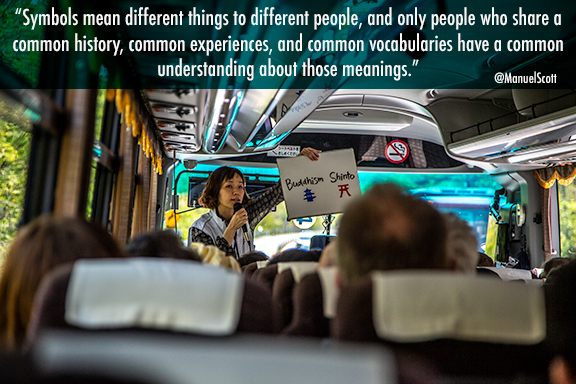
What Does Culture Have to Do With Teaching and Learning?
All communication, including teaching, takes place within a particular cultural context. That is, all communication occurs:
- In a particular place (your country, state, city, school, classroom)
- At a particular time (2020)
- In a particular language and dialect (English, Spanish, Spanglish, etc…)
- To a particular group of people who has particular patterns of thinking, feeling, and behaving.
Your school is situated or enveloped by the cultural context of your nation, state, city. In addition to that, you carry your own cultural background into your classroom. It might come as a surprise to you, but you are not completely objective as a teacher. You are not value-neutral. You have patterns of thinking, feeling, and behaving. Those patterns are called culture, and you learned those patterns, through a language and dialect, from people while you were growing up. Words are vehicles of culture transfer. In that sense, your brain has been programmed. When you were growing up, the software of your culture was downloaded on the hardware of your brain, and it affects nearly everything about you. (Click HERE to read my post, "What is Culture?")
So every day you enter your classroom, you carry with you certain convictions, philosophical assumptions, values, biases, and influences. You have assumptions and beliefs about people. You have assumptions and beliefs about the nature of reality. You have assumptions and beliefs about what counts as knowledge and how such knowledge can be learned. You also have assumptions and beliefs about what is right and wrong. You have assumptions and beliefs about education, and so on.
What does this mean for you as a teacher? It means that every lesson you try to teach your students reflects the culture in which you were raised not only in terms of words, grammar, and style, but also, and more importantly, in terms of the patterns of thinking, feeling, and behaving.
Furthermore, your students have been shaped by their own cultures in terms of words, grammar, style, as well as patterns of thinking, feeling, and behaving that they share with a group of people.
If you do not understand your own cultural background, you can make a person feel reject
With this in mind, we can add to our definition of communication. What is effective communication?
Effective communication is a symbolic, interpretive, contextual process in which people create shared meaning.
Teaching involves cultural context.
Click HERE to see How Culture Influences Teachers and Teaching
At this point, you might be asking, “Manny, what can I as a teacher do to reduce the linguistic and cultural gaps between me and my students, so we can, together, create shared meaning; and, so they can be more engaged, and learn?" That’s where the next element of the communication process comes in.
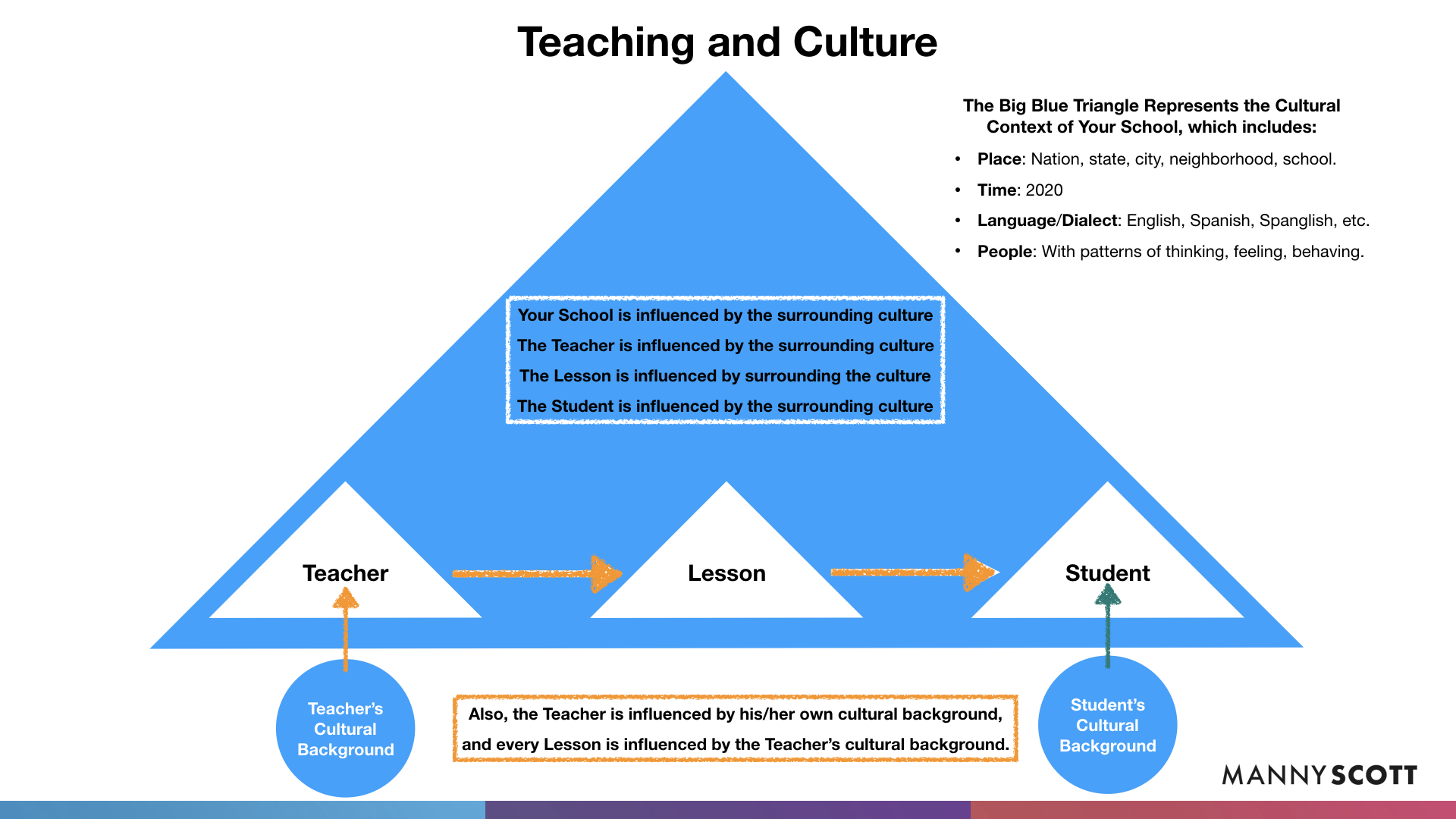
What Can You Do to Create a Shared Meaning with Your Students?
Whenever you and your students interact with one another (using and interpreting symbols, in your classroom (cultural context)), you work together to create and sustain the meanings that you both developed during your interactions with them. In other words, you keep talking to one another, back and forth, until you both share a common understanding about whatever is you’re talking about. This aspect of the process is not easy, especially if the gaps between you and your students is wide.
The wider the cultural and linguistic gap between you and your students, the more you are going to have to work to bridge that gap. But there is hope.
Clifford Geertz (1977), a prominent American anthropologist who helped define the field of anthropology, explains
“Cultural analysis is (or should be) guessing at meanings, assessing the guesses, and drawing explanatory conclusions from the better guess, not discovering the Continent of Meaning and mapping out its bodiless landscape” (Geertz 1977, 20).
In other words, when your students have a different culture than you, you do not need to understand everything about their culture. Rather, just try to understand something about them and their culture.
So when teaching your students, you should do your best to “fix” as accurately as possible the meaning of what you have seen your students do and heard them say, and humbly admit that what you have “fixed” may not be accurate.
It is not necessary for you to know everything in order to understand something. In your quest to teach students, then, your job is to keep guessing at meanings in order to understand something about them.
Ultimately, your knowledge of culture, cultures, or a culture will grow, as Geertz says, "in spurts" (25). You will never be able to get “to the bottom of things” because cultural analysis is intrinsically incomplete (29).
So, with that in mind, we need to add one final element to our definition of communication. What is effective communication?
Effective communication is the symbolic, interpretive, contextual, transactional process in which people create shared meaning.
Teaching is transactional—it involves an ongoing effort of guessing and re-guessing.
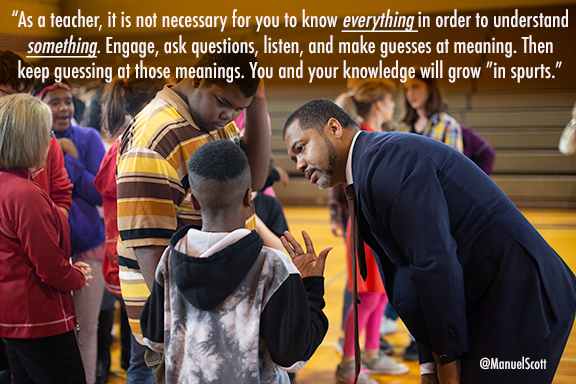
What, then, is Effective Communication?
If the goal of communication is the creation of shared meanings, then effective communication involves you having the awareness, knowledge, and skills to speak and behave in ways that create shared meaning with your students. Effective communication involves doing whatever you need to do as a teacher—using not only verbal communication skills such as words and sounds as well as non-verbal communication skills like eye contact, hand gestures, active listening, body language, and tone of voice, to make sure you and your students are on the same page. It means using, over and over again, your knowledge about symbols, interpretation, and cultural context to create shared meaning.
The best teachers work, through trial-and-error, to become effective communicators because they know that, in many cases, even on their worst days, they can be their students' best hope.
Summary
- Communication is a process that involves you, the Teacher, you Lessons, and your Students.
- The goal of communication is the creation of shared meaning between you and your students.
- Your words, sounds, facial expressions, actions, and non-actions are symbols.
- Your school is situated in a much broader cultural context.
- Your cultural background influences what, why, and how you teach.
- Your students’ cultural backgrounds influence what, why, and how they learn.
- If you do not share the cultural background of your students, there is a cultural gap between you and them.
- You can bridge that gap through guessing at your guesses.
This post is a great start to understanding effective communication, but I recommend you download my free resource, “How to Immediately Become a Better Student of Your Students without Adding Any More to Your Already-Full Plate.”
It will empower you to:
- Cultivate deeper understandings of, and more fulfilling connections with, your students.
- Raise your students’ achievement.
- Become an even more amazing teacher (you're already awesome because you are still reading this!).
At the bottom of this page, you can download “How to Immediately Become a Better Student of Your Students without Adding Any More to Your Already-Full Plate.”
Please share it with teachers you know.
References
Blumer, Herbert. 1986. Symbolic Interactionism: Perspective and Method. University of California Press.
Dance, Frank E. X, and Carl E Larson. 1976. The Functions of Human Communication: A Theoretical Approach. New York: Holt, Rinehart and Winston.
Geertz, Clifford. 1977. The Interpretation Of Cultures. First Edition edition. New York: Basic Books.
